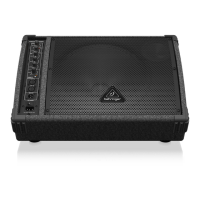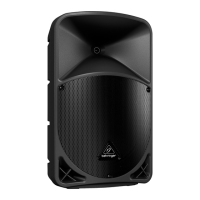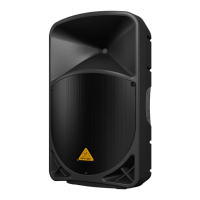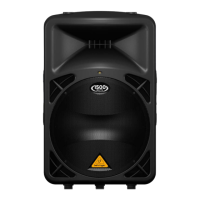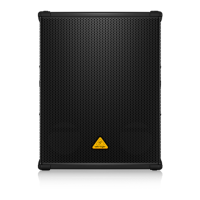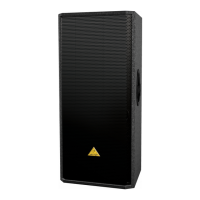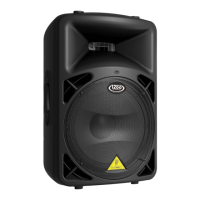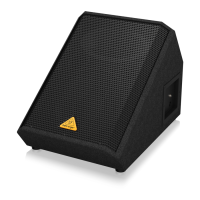EUROLIVE F1220A
Control elements and connections6
Control elements and connections2.
Top panel2.1
First group controlFig. 2.1:
{1} The POWER LED lights up when the loudspeaker is put into
operation.
{2} The CLIP LED lights up when signal distortion occurs.
Reduce the volume with the LEVEL control until the CLIP
LED does not light up any more, or occasionally lights up at
signal peaks.
{3} To set the volume of the LINE or MIC signal, use the LEVEL
control. The left half of the control range is for attenuating
the LINE signal. The right half is for raising the level of the
MIC signal.
Level adjusting: Turn the LEVEL control whose signal you
want to adjust slowly to the right until the CLIP LED {2}
lights up only at signal peaks. The LED is not supposed to
glow continuously.
We would like to draw your attention to the fact that ex- +
tremely loud sound levels may damage your hearing as
well as your headphones/loudspeakers. Turn the LEVEL
control fully to the left before you switch on the unit. Be
careful to select a suitable volume at all times.
EqualizerFig. 2.2:
{4} The F1220A features a 3-band sound control. Each band
provides a maximum boost/cut of 15 dB. At center position
the equalizer has a at response.
The upper (EQ HIGH) and the lower band (EQ LOW) are
shelving lters that boost and cut all frequencies above and
below the crossover frequency. The crossover frequencies
of the upper and lower bands are at 12 kHz and 80 Hz, re-
spectively. The mid band (EQ MID) is a peak lter the center
frequency of which is at 2.5 kHz.
Feedback lter (notch lter)Fig. 2.3:
Feedback may occur at high volume levels or under difcult stage
situations. Use the FEEDBACK FILTER function ({5}, {6}) to
reduce feedback. To learn more about the feedback lter, read
section 3.4 “Notch lter.”
{5} This switch turns on the feedback lter.
{6} This control adjusts the center frequency of the feedback
lter.
LINK OUTPUTFig. 2.4:
{7} + {8}
The LINK OUTPUT is directly connected to the inputs of
the F1220A and carries the input signal with no processing
applied. In this way, you can route the signal to the input of
another device (for example, a second F1220A).
MIC/LINE INPUTFig. 2.5:
{9} Use this 1/4" stereo jack to connect a signal source that has
1/4" output.
(10) Use this XLR connector to connect a signal source that has
XLR output.
Always use either the XLR or the 1/4" jack input, and use +
the LEVEL control to adapt the input sensitivity. Never
use both inputs at the same time!
Side panel2.2
Side panel F1220AFig. 2.6:
(11) Press POWER to turn on your F1220A.
The POWER switch does not fully disconnect the unit +
from the mains. To disconnect the unit from the mains,
pull out the main cable plug or appliance coupler. When
installing the product, ensure the plug or appliance
coupler is readily operable. Unplug the power cord
completely when the unit is not used for prolonged
periods of time.
(12) You can replace fuses at the FUSE SWITCH of the F1220A.
Always replace fuses with the same type. Please follow the
instructions given in the chapter “Specications.”
(13) The mains connection is established using a cable with
an IEC mains connector. This cable is delivered with the
F1220A. To avoid ground-loop hum, loudspeakers and
mixing consoles should be connected to the same power
circuit.
(14) Serial number
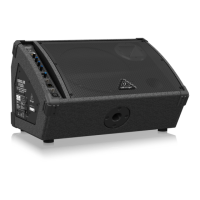
